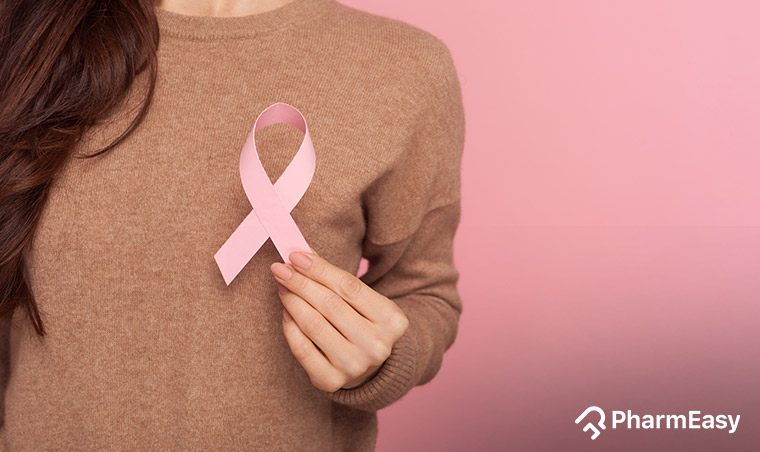Understanding The Signs And Risk Factors For Breast Cancer
By Shantanu Sodhi +2 more

Download PharmEasy App




Register to Avail the Offer
Send OTPBy continuing, you agree with our Privacy Policy and Terms and Conditions
By Shantanu Sodhi +2 more
The world over, several governments, international institutions as well as women who have survived breast cancer recognise October as the month of Breast Cancer Awareness. In the spirit of awareness, today we too shall go over breast cancer symptoms and also risk factors for the same.

As with all cancers, catching this condition early improves the survivability rate. That is why you should check yourself regularly for breast cancer symptoms and inform your doctor if you notice anything unusual or new.
Table of Contents
Cancer is a type of disease in which some cells mutate and begin multiplying rapidly. These cells form lesions, lumps, tumours and can obstruct normal bodily functions. Some cancer can metastasize, meaning it spreads and affects other parts of the body. This spread is referred to as ‘metastasis’.
Breast cancer follows a similar path. It is cancer (out of a total of 100 types) that begins in the tissue of the breast but with time it can spread to other areas. Ductal Carcinoma is a common type of breast cancer, it accounts for approximately 70% to 80% of breast cancer cases.
Due to many years of awareness and research, it has become easier to treat breast cancer through various means. But identifying the warning signs and symptoms of breast cancer in the early stages is what makes or breaks the success rate of the treatment. After self-examination of your breasts and underarm areas during shower or when you are changing your clothes, here are a few additional signs which are equally important and you can check for:
Note that, if you have any of the above conditions singularly it is not a clear indication that you have breast cancer for sure. Similar signs are associated with other medical issues as well. If you discover a few of the mentioned signs and symptoms of breast cancer together, be sure to see your doctor about it.
Breast cancer risk is a combination of multiple factors, some of which can be altered and others are part of your genetic makeup. If you are at high risk, it does not necessarily mean you will get breast cancer. Conversely, even if you do not have any of the below breast cancer risks, you can still develop cancer.
Unlike the previous section the following factors can be managed and controlled to help reduce your risk of developing breast cancer:
While developing breast cancer may be a scary thought, breast cancer treatments have progressed a lot over the past few decades. The main purpose of this article is to raise awareness of the potential breast cancer symptoms. If you notice any of the signs covered here, or you think you may be at a higher risk then speak to a doctor at the earliest. Pass this short article on to your friends as well, and let’s help to raise awareness all through this month!
Also Read: What is the Cause of Nipple Pain? Understanding and Managing Discomfort
Disclaimer:
The information provided here is for educational/awareness purposes only and is not intended to be a substitute for medical treatment by a healthcare professional and should not be relied upon to diagnose or treat any medical condition. The reader should consult a registered medical practitioner to determine the appropriateness of the information and before consuming any medication. PharmEasy does not provide any guarantee or warranty (express or implied) regarding the accuracy, adequacy, completeness, legality, reliability or usefulness of the information; and disclaims any liability arising thereof.
Links and product recommendations in the information provided here are advertisements of third-party products available on the website. PharmEasy does not make any representation on the accuracy or suitability of such products/services. Advertisements do not influence the editorial decisions or content. The information in this blog is subject to change without notice. The authors and administrators reserve the right to modify, add, or remove content without notification. It is your responsibility to review this disclaimer regularly for any changes.
Comments